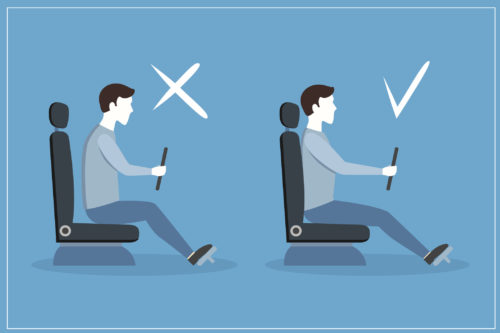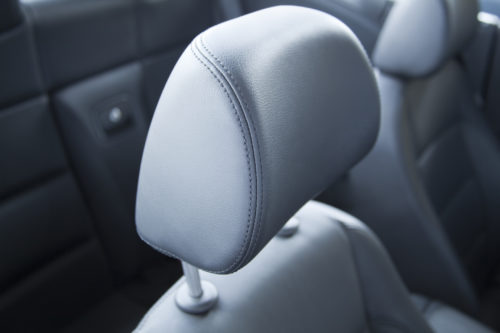World Health Day: The Correct Driving Posture Matters More Than You Think
Staying in shape is a combination of several factors such as healthy relationships, work-life balance, stress management, nutritious diet, regular exercise, and even a good driving posture. So, this World Health Day – April 7, a day globally observed to raise awareness about good health, go the extra mile and make an effort to adopt some healthy habits, even while driving.
Importance of Good Driving Posture

Poor driving posture can affect your health and cause muscle tightness, joint pain, stiff neck, circulation problems, spinal alignment issues, lower back pain, and more. Besides taking a toll on your body, it also makes the driving experience uncomfortable and strenuous. Therefore, it is important to find the right seating position. A good ergonomic setup enhances driving efficiency, comfort, and safety. You get better visibility, you stay alert and ready to react quickly to any situation, and of course, no more aches and pains!
Want to maintain the ideal driving posture? Here’s what you should do as soon as you get behind the wheel:
Empty Your Pockets

Pockets are a go-to spot for your keys, wallet, and other belongings. But did you know that this habit, especially keeping stuff in the rear hip pocket, is bad for you and your posture? A full pocket raises one side of your body, which causes your pelvis and spine to position in a way that isn’t straight or natural. Over time, this can result in serious pain in your hip, back, sciatic nerve, and leg. Similarly, the front pocket causes a pinch between your torso and thigh, resulting in sundry aches and pains. So, before you drive, take bulky things like wallet and phone out of your pocket, so you feel even pressure on both the right and left side of the pelvis. This ensures you are in a comfortable position and can concentrate on driving.
All Ford cars have around 20 smart storage compartments throughout the car. This way, you can place your belonging in them and empty your pockets.
Sit Straight

Unconsciously, we often tend to slouch or hang our head, leaving the back unsupported. Such postures cause tension in the muscles around the neck and back. You need to ensure your lumbar area and shoulders are supported at all times. Keep the pelvis upright and slide your tail bone as close to the seat back as possible. This doesn’t mean you sit for 60 minutes at a 90-degree angle; you’ll be uncomfortable and fatigued in no time. Instead, recline your seat to 100-110 degrees. It shouldn’t feel as though you’re tipping forwards or leaning backward; you should be able to sit back and allow the seat to support you.
Ford cars offer accessories like pillows and neck-rest for extra cushioning. They are made of special recron fibre and solid foam; they ensure optimal comfort and support.
Keep Your Arms Relaxed

Try extending your arms straight in front of your chest. Your back automatically straightens up, and your posture improves. This holds good when you drive too. Hold the steering wheel loosely, ensure your arms are relaxed and bend your elbows slightly. Avoid a rigid grip and fully extended arms. Keep moving your fingers so they don’t cramp and rest each arm for a few seconds during a red light. But don’t make the mistake of being too relaxed and resting an elbow on the windowsill and holding onto the steering with one arm. This can impair your control over the car, especially in emergencies. Additionally, leaning one arm on the door or console can lead to the ribcage shifting to one side and eventually pulling on the spine. This can be harmful in the long run.
Both Feet Flat On The Ground

Proper foot position allows you to stabilise your torso and evenly distribute any pressure. In an automatic car, always rest your left foot on the dead pedal. If it’s a manual transmission, don’t ride the clutch. Adjust the seat so that you can comfortably depress the pedals with slightly bent knees and without your back losing contact with the seat. At the same time, you should rest your thighs on the seat without undue pressure. The optimal distance between the back of your knees and the edge of the seat is 3-6 cm. This ensures you don’t put any pressure behind your knees.
Adjust The Headrest

All this time, you have been using the headrest for extra comfort. But if the height is wrong, it’s not serving its purpose. A headrest that’s properly adjusted can reduce muscle strain. Headrests are intended to align your neck and head with your torso and prevent any injuries during collisions. Position your headrest at the ear level directly behind your head. If it is too high or low, it won’t offer adequate support. While a headrest alone won’t guarantee protection, Ford Endeavour offers power-adjustable seats that can be moved in 16-ways at the touch of a button. This offers greater support and comfort to the body.
Watch Your Posture
While finding the correct seating alignment may seem inconsequential at first, but once you try it out, you’ll notice the difference, and there’s no looking back. A few small changes can go a long way in making you feel better. Along with your passion for driving, it’s time to take your health more seriously this World Health Day!
Subscribe to our newsletter
Subscribe to our newsletter to stay upto date with latest news, offers and much more



